So, what then do we make of Jews for Baby Jesus? You know — those members of the Tribe of Judah who have written and recorded some of the world’s most beloved songs celebrating the season of Christ’s birth. Irving Berlin composed “White Christmas.” Jews Ray Evans and Jay Livingston (born Jacob Harold Levison) wrote “Silver Bells.” Christmas-crazy Jew Johnny Marks penned such classics as “Rudolph the Red-Nosed Reindeer,” “Rockin’ Around the Christmas Tree,” “A Holly Jolly Christmas,” and “Run Rudolph Run.” Let’s face it, Jews write some pretty catchy tunes. If George and Ira Gershwin can realistically portray a slice of African American life by writing “Porgy and Bess,” then Mel Tormé (surprise! a Jew!) can give us that somewhat unrealistic Ozzie and Harriet image of happy Christians “roasting chestnuts on an open fire.”
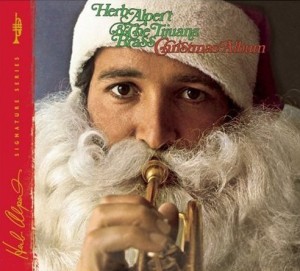 And admit it — how many times have you thrown a yule log on the fire, cranked up the Hi-Fi, and noshed on lox and cream cheese while enjoying a Christmas record by Barbra Steisand, Neil Diamond, Herb Alpert, Bette Midler or Barry Manilow? Even America’s most revered punk rocker, the late Joey Ramone (a Jew born Jeffrey Ross Hyman) – famous for his little ditties about sniffing glue and beating on brats with baseball bats – revealed his gentler side when he composed “Merry Christmas (I Don’t Want to Fight Tonight.)” Hey, Ho, Let’s Go – Ho, Ho, Ho!
And admit it — how many times have you thrown a yule log on the fire, cranked up the Hi-Fi, and noshed on lox and cream cheese while enjoying a Christmas record by Barbra Steisand, Neil Diamond, Herb Alpert, Bette Midler or Barry Manilow? Even America’s most revered punk rocker, the late Joey Ramone (a Jew born Jeffrey Ross Hyman) – famous for his little ditties about sniffing glue and beating on brats with baseball bats – revealed his gentler side when he composed “Merry Christmas (I Don’t Want to Fight Tonight.)” Hey, Ho, Let’s Go – Ho, Ho, Ho!
But, in the words of Jewish vaudeville sensation Al Jolson, when it comes to Jews crooning carols, “You ain’t heard nothin’ yet!” The distinct nasal droning of rock’s premier poet, Bob (Zimmerman) Dylan, will be blowin’ in the Christmas wind when I crank up his 2009 album, “Christmas in the Heart.” Now I admit, I don’t listen to a single holiday song on any of my Apple devices, unless it’s one of those rare, reality-based gritty urban tunes like The Pogues’ “Fairytale of New York” (It was Christmas eve, babe / In the drunk tank / An old man said to me: won’t see another one…). I’ve even been known to cut short my visits to Macy’s shoe department when “sleigh bells jingling” start to ring-ting-tingle my brain.
But Bob Dylan singing Christmas carols? Lords a-leapin’ – that’s a whole ‘nother story! I mean, do you hear what I hear?
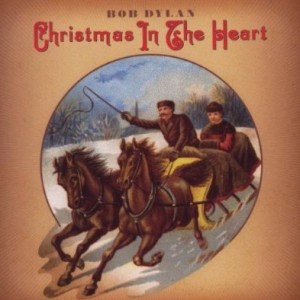 I think Jesus listens to Bob’s music all the time. Heck, their back pages are so similar. Bob, like Jesus, is a Jew. Like Jesus, he was considered by many to be the Messiah of their generation. They both spoke in mystical ways and were often misunderstood. Like Jesus, Bob toured the region and had groupies. Like Jesus, he was persecuted by his own people – in Bob’s case, by the folkies who felt he sold out by “going electric.” Of course, that’s where the similarities end. This is called satire, people. Don’t get your knickers in a twist. I am NOT implying that Bob Dylan is Christ-like, or even that he’s bigger than Christ. We all know how that remark almost cost John Lennon his life at the hands of those hatin’, cross-burning Christian KKK guys.
I think Jesus listens to Bob’s music all the time. Heck, their back pages are so similar. Bob, like Jesus, is a Jew. Like Jesus, he was considered by many to be the Messiah of their generation. They both spoke in mystical ways and were often misunderstood. Like Jesus, Bob toured the region and had groupies. Like Jesus, he was persecuted by his own people – in Bob’s case, by the folkies who felt he sold out by “going electric.” Of course, that’s where the similarities end. This is called satire, people. Don’t get your knickers in a twist. I am NOT implying that Bob Dylan is Christ-like, or even that he’s bigger than Christ. We all know how that remark almost cost John Lennon his life at the hands of those hatin’, cross-burning Christian KKK guys.
Unlike other Jews who write and sing about Christmas, however, Bob had at least some actual experience with the New Testament. I guess you don’t have to be born a Christian to become “born again.” And that’s exactly what Mr. Dylan did in the late 1970s. A messy divorce, coupled with the ill effects of non-stop touring, notorious womanizing and excessive drinking led him to seek shelter from the storm. And he found it, in the form of Jesus. He once said, “There was a presence in the room that couldn’t have been anybody but Jesus. I truly had a born-again experience, if you want to call it that…. It was a physical thing. I felt it all over me. I felt my whole body tremble.”
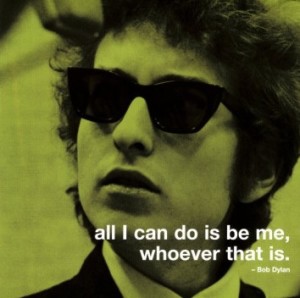
His conversion to Christianity outraged many, but Bob was never one to cater to the expectations of fans or peers. He released two Christian albums – “Slow Train Coming” in 1979 and “Saved” in 1980. While recording the former LP, he tried to convert record producer Jerry Wexler to Christianity, to which Jerry replied, “Bob, you’re dealing with a sixty-two-year old Jewish atheist. Let’s just make an album.” But Bob was truly on a mission. During his 1979 tour, he preached to the audience: “I told you the answer was ‘Blowin’ In The Wind’ and it was! And I’m saying to you now, Jesus is coming back and he is! There is no other way to salvation…Jesus is coming back to set up his kingdom in Jerusalem for a thousand years.” Wow, was Bobby still dropping acid at that time?
Well, thankfully, Mr. Dylan eventually tired of all this proselytizing, and became….well, one of his myriad “old selves” again (he’s a Gemini, you know). After many years, he reconnected with his Jewish roots, even visiting the Wailing Wall in Jerusalem on the day of his son’s bar mitzvah in 1983. He’s long been a supporter of the Chabad Lubavitch movement and once appeared on a Chabad telethon.
But even though he’s no longer a full-time Christian, he believes that Christmas tunes are an integral part of America’s rich folk song tradition. When former Musician magazine editor Bill Flanagan told Dylan during a November 2009 interview that he delivered “O Little Town of Bethlehem” like “a true believer,” Bobby replied, “Well, I am a true believer.”
 So, if you’re a fan of Bob Dylan – no matter what your faith or lack thereof – give his “Christmas in the Heart” album a go. The record received favorable reviews, with many critics praising the sincerity with which he performs the songs. Royalties from the sale of the CD benefit a number of charities: Feeding America in the USA, Crisis in the UK, and the World Food Programme.
So, if you’re a fan of Bob Dylan – no matter what your faith or lack thereof – give his “Christmas in the Heart” album a go. The record received favorable reviews, with many critics praising the sincerity with which he performs the songs. Royalties from the sale of the CD benefit a number of charities: Feeding America in the USA, Crisis in the UK, and the World Food Programme.
I only wish he had written one original holiday tune for his album. But since he didn’t, I’ve taken the liberty of penning Christmasy lyrics to one of Bob’s most interesting and acerbic songs: “Ballad of a Thin Man,” from the 1965 album that changed my life, “Highway 61 Revisited.”
“Ballad of a Fat Man”
You crawl out of the chimney
With a toy sack in your hand,
You see somebody passed out
And you say, “Who is that man?”
You try so hard
But you don’t understand,
Just what went on
In this guy’s home.
Because something is happening here
But you don’t know what it is.
Do you, Mr. Claus?
You shake off the soot,
And you ask, “Why did you drink?”
And the guy points to his wife and says,
“Whaddya think?”
And she sits on the couch and says,
“I poured the rest down the sink.”
And you say, “Oh my God,
Another reveler stoned!”
But you know something is happening here
But you just don’t know what it is.
Do you, Mr. Claus?
You hand out the presents,
And you sneer at the slob,
Who sobers up and realizes
You’re not there to rob.
And he says “How does it feel
To be such a blob?”
And you say, “Heathen!”
As you hand him some coal.
And something is happening here
But you just don’t know what it is.
Do you, Mr. Claus?
You have many contacts
Among the North Pole hacks
To get you facts
When some non-believer attacks your reputation.
But some people have little respect.
Anyway they still expect you
To give gifts to those who run despicable organizations.
You’ve been with the Easter Bunny.
And he’s laughed at your looks.
With great cherubim and seraphim
You’ve discussed atheists and kooks.
You’ve been through all of Dr. Stillman’s diet books,
You’ve very well read,
It’s quite known.
But something is happening here,
But you just don’t know what it is.
Do you, Mr. Claus?
Well, the reindeer, they come up to you
And they ask “How?”
They’ll haul your ass ’round the world
But you’re as big as a sow.
And you say, “Put these reins on,
or I’ll eat you as chow.”
And they say, “Drive that sleigh yourself,
We’re going home.”
And you know something is happening here
But you don’t know what it is.
Do you, Mr. Claus?
Now, here’s a rollicking version of Bob’s “Must Be Santa” – Klezmer style. It’s one of the most wonderfully wacky videos I’ve ever seen. Unlike the original, he inserts the names of eight U.S. presidents when he reads off the reindeer names: “Dasher, Dancer, Prancer, Vixen / Eisenhower, Kennedy, Johnson, Nixon / Dasher, Dancer, Prancer, Vixen / Carter, Reagan, Bush and Clinton.” The young man who jumps out the window at the end is rumored to be Bob’s son.
By Dana Spiardi, Dec 19, 2013
]]>
The winter’s fury resulted in at least a dozen snow days that year. And I spent the time sheltered, sans-siblings, in the bedroom of our four-room apartment. With no actual school work, I was free to feed my head with all kinds creative matter. I was an unchained enfant mélancolie, wide-open to ponder the meaning of life — to dissect the mysterious beast of High School Land. It was one of the most beautifully sad, soul-expanding periods of my life.
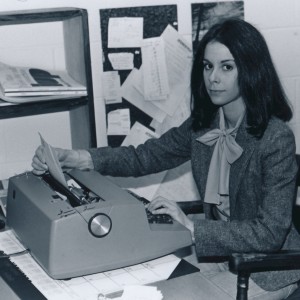 My last year of school was marked by periods of great output and even greater input. Like many self-conscious teenage girls, I soaked up and stored into permanent memory the slights, innuendoes, snickers, eye rolls and sideway glances of those around me, to the extent that I still remember where I was – and, sometimes, what I was wearing – when those that’s it, my life is over feelings washed over me. (Years later I was heartened to read this passage from Jackie Kennedy’s diary: if school days are the happiest of your life, I’m hanging myself with my skip rope tonight.) I studied my peers with a Freudian frenzy, but I studied myself even more.
My last year of school was marked by periods of great output and even greater input. Like many self-conscious teenage girls, I soaked up and stored into permanent memory the slights, innuendoes, snickers, eye rolls and sideway glances of those around me, to the extent that I still remember where I was – and, sometimes, what I was wearing – when those that’s it, my life is over feelings washed over me. (Years later I was heartened to read this passage from Jackie Kennedy’s diary: if school days are the happiest of your life, I’m hanging myself with my skip rope tonight.) I studied my peers with a Freudian frenzy, but I studied myself even more.
And I came to believe that Janis Ian, the misfit singer, had truly nailed it: I, too, learned the truth at seventeen. There would always be insiders and there would always be outsiders, and I would always be the latter. That sentiment was forever sealed within me, as I read and re-read J.D. Salinger and S.E. Hinton; watched and re-watched “Cool Hand Luke” and “Frankenstein”; listened to and re-listened to “I am a Rock” and “Strawberry Fields Forever.”
I was editor of my high school paper, wrote a school news column for the regional newspaper, and freelanced as a sports writer for the smaller hometown rag — covering high school basketball games for 5 cents a column-inch. It was all-consuming, as are most of my endeavors. Then, like now, my creative muse was a late night visitor, and I spent many a midnight hour beating the keys of my Sears-brand electric typewriter and repeating the Robert Frost mantra: and miles to go before I sleep. I was tired by day and prone to headaches. My spiritual health wasn’t much better: I was disillusioned by the cliquishness and conformity all around me. Those of us who didn’t drink and smoke dope were curiously called “rednecks.” Better dead, than red, my vapid peers used to say. Even the popular, letter-jacket crowd imbibed. Why, a member of our homecoming court actually upchucked (in the parlance of the day) all over her prom gown!
Oh, I knew the exact latitude and longitude of Gene Pitney’s “Town Without Pity,” alright: 40.4312° N, 79.2609° W.
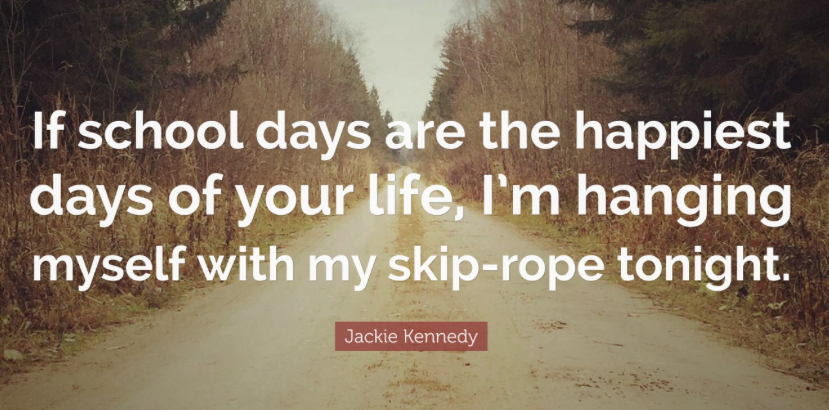 I’ll admit that most of my high school experience was pleasant enough. But things started to go south in year 4, when I began speaking out about some of the ugly behavior I witnessed in our class of 160. I was put down for writing a school newspaper editorial that chastised the jock-bullies who picked on a lonely obese boy. I was snubbed by the small, but all-powerful group of privileged “social Darwinists” when I openly criticized them for instigating trouble and getting off, scot-free. I became, in effect, a snob in my own right. I was an anti-snob snob, and it cost me the happiness that I should have experienced in that oh-so-sacred of American epochs: The Senior Year. I fancied myself a suffering artist. Thoreau, with his different drummer manifesto, was my literary poster boy. Emily Dickinson, with verses like I’m nobody! Who are you?, was a sad, kindred spirit. Yes, I turned into one self-absorbed mess of a gal. A heaping tablespoon of self-righteousness, mixed with two cups of self-pity and a dash of disdain make for one cold, bitter stew. But how delicious it was, at the time.
I’ll admit that most of my high school experience was pleasant enough. But things started to go south in year 4, when I began speaking out about some of the ugly behavior I witnessed in our class of 160. I was put down for writing a school newspaper editorial that chastised the jock-bullies who picked on a lonely obese boy. I was snubbed by the small, but all-powerful group of privileged “social Darwinists” when I openly criticized them for instigating trouble and getting off, scot-free. I became, in effect, a snob in my own right. I was an anti-snob snob, and it cost me the happiness that I should have experienced in that oh-so-sacred of American epochs: The Senior Year. I fancied myself a suffering artist. Thoreau, with his different drummer manifesto, was my literary poster boy. Emily Dickinson, with verses like I’m nobody! Who are you?, was a sad, kindred spirit. Yes, I turned into one self-absorbed mess of a gal. A heaping tablespoon of self-righteousness, mixed with two cups of self-pity and a dash of disdain make for one cold, bitter stew. But how delicious it was, at the time.
And today? Well, as Bob Dylan once sang: But I was so much older then; I’m younger than that now. Nowadays I’m somewhat happy to say that my spiritual health has greatly improved. Wellness? Nothing to it. It only involved lots of expensive therapy; two stints in rehab; thousands of AA meetings; ongoing physical exercise; the discovery of writers named Tolle, Hay, Chopra, and Brown; the consumption of pricey oral supplements; classes in aromatherapy and gemstone healing; consultations with tarot readers, astrologers, hypnotherapists, chakra re-balancers and assorted soothsayers; the suspicion that nearly everyone else could be as screwed up and insecure as I am; and a general feeling of who gives a shit.
But back in 1977, I felt as old as Methuselah, and doubted I’d ever be satisfied. Alas, there was one thing that always kept me hanging on: music.
So, by now you’re probably dying to know just what kinds of records were spinning around on my cheap little “Silvertone” sound machine during that period of intense introspection. What? You’re not? Well, too bad, ’cause I’m gonna tell you anyway. Below is a round-up of the records that were in heaviest rotation during that scrumptiously wicked winter…the tunes that best represented my mood-spinning state of mind.
Let’s start with a song from my daily diet of Cream – the British power trio, that is – a band of which guitarist Eric Clapton was a member. The first tune that always comes to mind when I reminisce about the storm of ’77 is “Passing The Time,” from the 1968 album “Wheels of Fire.” The slow, lullaby-like tempo of the song’s verse perfectly mirrored the drowsy, dreamy mood of my seclusion. It describes a woman who waits by the fire for “her traveler,” in the midst of a snowy winter. Oh, how I longed for a traveler to arrive at my door with all the answers.
Another song that conjures up memories of late-night contemplation is The Rolling Stones’ 1971 album cut, “Moonlight Mile,” with its exotic Asian vibe. Mmmm….I’m hidin’, baby, and I’m dreamin’. When Mick Jagger sang about a head full of snow, I didn’t realize then that he was referring to cocaine. For years I misinterpreted the line, I am just livin’ to be lyin’ by your side, as dyin’ by your side.” Which I found wildly romantic. I wanted somebody to die beside.
One of my Christmas gifts in 1975 was “The Who By Numbers,” an album described by some as “Pete Townsend’s suicide note.” It was full of serious songs about fear, alienation, self-loathing, and self indulgence. Snap! The LP’s opener, “Slip Kid,” became my spirit of ’77 theme song, with its refrain: Slip kid, slip kid, second-generation, only half way up the tree…slip kid, slip kid, realization: there’s no easy way to be free.
Moving right along with my U.K. collection of mood-tunes, I can’t leave out the songs of Faces, a band once fronted by Rod Stewart. Their 1971 LP, “A Nod is as Good as a Wink…To a Blind Horse,” featured a number that fit nicely with the other melancholy winter songs: “Debris,” written and sung by band co-founder Ronnie Lane. It’s a bittersweet love song to his father, set amid a blighted, post-war London marketplace.
Dreary Brits, step aside! The Yanks are coming – with their own brand of wistfulness. First, there’s Bruce Springsteen. He sure knows a thing or two about outsiders, galvanizing legions of outcasts with songs like “Born to Run,” “Jungleland” and “Backstreets.” But it was one of his lesser-known songs, “Meeting Across the River,” that moved me to my core. This musically-sparse tune – featuring nothing but piano, accented with haunting, jazz-club trumpet flourishes – tells the story of two last-chance Jersey losers hoping to score in the Big Apple. I’ve seen Bruce more than 20 times, but I’ve only ever heard him play this song live one time – in 1976.
And now we end (hold your applause, please) with The Maestro, Bob Dylan. Throughout my life, it was The Beatles who spoke to my heart, but it was Dylan who spoke to my soul. I discovered his masterpiece, “Highway 61 Revisited,” nearly ten years after its 1965 release. And my life would never be the same. This album, more than any other, was the soundtrack to my senior year (and remains the most important recording in my collection). Each song spoke to me in a very profound way. I related to every situation and character in Dylan’s desolation row of unfortunates: Miss Lonely and the Princess on the Steeple of “Like a Rolling Stone,” Sweet Melinda of “Just Like Tom Thumb’s Blues,” the graveyard woman of “From a Buick 6,” the factory mama of “Tombstone Blues,” even Mr. Jones of “Ballad of a Thin Man.” When the phonograph needle hit the sweet spot on “Tom Thumb’s Blues,” and I heard Bob wail, everybody said they’d stand behind me when the game got rough / But the joke was on me, there was nobody even there to bluff,” I knew I was HOME. Listening to Highway 61 was a revelation: someone, somewhere, understood. The record hinted that others, too, were searching for answers. Was Dylan writing as a form of self-therapy or self-amusement, or was he bent on delivering a message to the disenfranchised masses, as Springsteen would do a decade later? It didn’t matter. And it didn’t matter that I couldn’t, and never will, completely grasp the songs’ meanings. This record is art incarnate, and like all great works, it’s wide open to interpretation. It’s best left as enigma.
These records, and so many more, were a key part of my true “coming of age.” I listen to them now as often as I did during those bleak winter days 36 years ago. But now my moody, confused periods are far fewer. Hopefully, they’ll never vanish altogether. They are, after all, necessary. I still relish a good funk.
In the end, I managed to find my way, and partake of life’s rich banquet (okay, I know that’s a lame phrase, but I only used it so that I could point out that REM stole the line from Peter Sellers in the Pink Panther movie, “A Shot in the Dark.”)
Anyway, Bruce sums it up best: My feet, they finally took root in the earth. But I got me a nice little place in the stars.
Now,here’s an empowerment song for all you angst-ridden, high school-hating teens! Play it LOUD and scream along.
By Dana Spiardi, Jan 27, 2013
]]>
Being swept off the street by a rock star may be nothing more than a wet dream for yer blogger, but this really did happen to a young violinist named Donna Shea, better known as Scarlet Rivera.
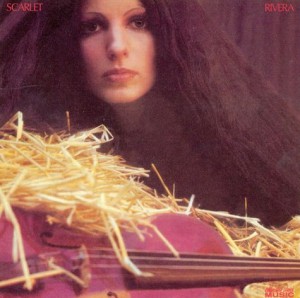 One summer day in 1975, Ms. Rivera, violin case in tow, set out from her apartment in New York’s bare-knuckle Lower East Side, erstwhile home of your huddled masses. She was headed to a friend’s house to kill some time prior to a rehearsal with a long-forgotten Latin band. All of a sudden a car cuts her off at an intersection, a woman leans her head out the window, and asks her if she really can play the violin. Scarlet peers into the car and spies none other than Napoleon in Rags himself – Bob Dylan – in the driver’s seat. Bobby ordered his companion, percussionist Sheena Seidenberg, to ask Rivera for her phone number. Was it the young woman’s exotic looks, gypsy flair, or violin case that piqued Bob’s interest? Let’s just say that factor number 3 probably wouldn’t have mattered much if it weren’t for factors 1 and 2. (Bob’s boot-heels never stopped wandering). Anyway, Rivera declined to relinquish her number. Bobby said he was headed downtown to rehearse; why not join him? Scarlet said she was headed uptown to rehearse; no thanks. And then – perhaps wanting to breathe the same rarefied air as Bob, or sensing something might come of this chance encounter – she boldly asked him for a ride to her rehearsal destination.
One summer day in 1975, Ms. Rivera, violin case in tow, set out from her apartment in New York’s bare-knuckle Lower East Side, erstwhile home of your huddled masses. She was headed to a friend’s house to kill some time prior to a rehearsal with a long-forgotten Latin band. All of a sudden a car cuts her off at an intersection, a woman leans her head out the window, and asks her if she really can play the violin. Scarlet peers into the car and spies none other than Napoleon in Rags himself – Bob Dylan – in the driver’s seat. Bobby ordered his companion, percussionist Sheena Seidenberg, to ask Rivera for her phone number. Was it the young woman’s exotic looks, gypsy flair, or violin case that piqued Bob’s interest? Let’s just say that factor number 3 probably wouldn’t have mattered much if it weren’t for factors 1 and 2. (Bob’s boot-heels never stopped wandering). Anyway, Rivera declined to relinquish her number. Bobby said he was headed downtown to rehearse; why not join him? Scarlet said she was headed uptown to rehearse; no thanks. And then – perhaps wanting to breathe the same rarefied air as Bob, or sensing something might come of this chance encounter – she boldly asked him for a ride to her rehearsal destination.
Once inside what Rivera describes as an “ugly green” station wagon (long rumored to have been a limo), Bob must have eked out whatever charm he stowed away for chick baiting and/or musician hiring, and the next thing you know she’s in his studio, playing along with him while he rehearsed several songs for his upcoming album, “Desire.” The mercurial Dylan is not an easy man to accompany, but the classically trained Rivera gave it her best, and managed to follow along with him while he played guitar and piano. Bob liked what he heard, and treated her to a night on the town. Within the course of one evening, Rivera would watch Muddy Waters perform on stage, mingle with him and his band at the Brooklyn home of blues singer Victoria Spivey, and jam with Bob long into the night.
Dylan has released 35 studio albums since 1962. His best LPs are lyrically poetic and defined by signature sounds – be they from Mike Bloomfield’s screaming electric guitar, Al Kooper’s Hammond organ, Paul Griffin’s piano, or Bob’s own acoustic guitar and harmonica. But never did the sound of a mystical violin figure prominently in any of his music. Until he asked Scarlet Rivera to play on “Desire.”
I own lots of Bob’s albums, and aside from my favorite, “Highway 61 Revisited,” “Desire” is the one I’ve probably played more than any other. It may not be considered an essential, times-a-changing disc, in the same league with “The Freewheelin’ Bob Dylan,” “Bringing It All Back Home,” “Highway 61,” “Blonde on Blonde,” and “Blood on the Tracks.” There’s little dissection of self and psyche here. But! No other Dylan LP sounds like “Desire” – thanks to the contributions of Ms. Rivera. It’s the mysterious, Eurasian gypsy vibe of her violin that conjures up past lives, that makes me feel like I’m wrapped inside every story-song on this album. I’m hunting gold in icy pyramids…and watching the last ship sail from Black Diamond Bay. I’m drinking white rum in a Portugal bar…and riding past Aztec ruins and the ghosts of my people. Hoofbeats like castanets on stone. Rivera plays like a woman possessed. Her strings set the mood of every mythical song.
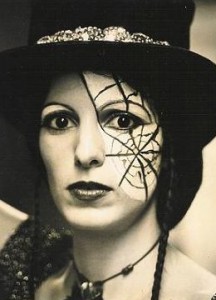 Aside from Bob’s writing collaboration with members of The Band during the Big Pink/Basement Tapes sessions, “Desire” marks his first real foray into co-writing. Dylan composed seven of the LP’s nine songs in partnership with songwriter/theater director Jacques Levy. (Levy’s background as a clinical psychologist must have come in handy when working with a capricious artist like Bob.) Two of the album’s songs stirred controversy. “Hurricane” — about the wrongful imprisonment of Rubin “Hurricane” Carter, a middleweight boxer charged with triple murder in 1966 — was criticized for its inaccuracies and libelous accusations. Yet, it did much to publicize Carter’s case; the conviction was overturned in 1985. “Joey,” an accordion-drenched paean to mafioso “Crazy Joe” Gallo, was viewed as a sappy lionization of a murderer. Still, the album maintained the number one spot on the Billboard Hot 100 for five weeks, beginning on February 7, 1976. For what it’s worth, Rolling Stone lists it as number 6 among Dylan’s best albums, and #174 on its list of The 500 Greatest Albums of All Time.
Aside from Bob’s writing collaboration with members of The Band during the Big Pink/Basement Tapes sessions, “Desire” marks his first real foray into co-writing. Dylan composed seven of the LP’s nine songs in partnership with songwriter/theater director Jacques Levy. (Levy’s background as a clinical psychologist must have come in handy when working with a capricious artist like Bob.) Two of the album’s songs stirred controversy. “Hurricane” — about the wrongful imprisonment of Rubin “Hurricane” Carter, a middleweight boxer charged with triple murder in 1966 — was criticized for its inaccuracies and libelous accusations. Yet, it did much to publicize Carter’s case; the conviction was overturned in 1985. “Joey,” an accordion-drenched paean to mafioso “Crazy Joe” Gallo, was viewed as a sappy lionization of a murderer. Still, the album maintained the number one spot on the Billboard Hot 100 for five weeks, beginning on February 7, 1976. For what it’s worth, Rolling Stone lists it as number 6 among Dylan’s best albums, and #174 on its list of The 500 Greatest Albums of All Time.
And, as for Scarlet Rivera, she went on to tour with Dylan’s carnival-like Rolling Thunder Revue, which featured a roaming band of minstrel rockers that included Joan Baez, Joni Mitchell, Roger McGuinn, Ramblin’ Jack Elliott, Kinky Friedman, T-Bone Burnett and Mick Ronson. She released two solo albums in the 1970s, toured and recorded with such artists as Tracy Chapman, Indigo Girls, Keb’ Mo’ and David Johansen, and played as a soloist with the Duke Ellington Orchestra at Carnegie Hall and the Kennedy Center. And she’s still on the scene – writing, recording and performing a wide range of music, from Celtic and World Music to instrumental New Age. But it’s her work with Dylan, and the serendipitous nature of their initial meeting, that’s the stuff of rock history.
(There. I managed to get through this entire article without once using Dylan’s “Simple Twist of Fate” song title to describe Rivera’s rise to fame.)
Here’s a clip featuring Scarlet’s music. This is a promo for a concert commemorating the 30th anniversary of Dylan’s Rolling Thunder Revue.
© Dana Spiardi, Feb 10, 2013
]]>
So, what song could the defense attorney possibly be citing? It’s 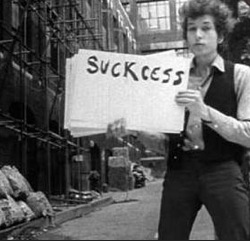 Bob Dylan’s word-twister from 1965, “Subterranean Homesick Blues,” one of the most influential and imitated songs in popular music. With its random satirical lyrics delivered in rapid-fire deadpan style, Bob takes aim at the emerging social strife of the day: civil rights battles (better stay away from those that carry around a fire hose), the burgeoning drug scene (Johnny’s in the basement mixing up the medicine), and authority figures (don’t follow leaders / watch the parking meters.) It’s like a sociopolitical jump rope chant.
Bob Dylan’s word-twister from 1965, “Subterranean Homesick Blues,” one of the most influential and imitated songs in popular music. With its random satirical lyrics delivered in rapid-fire deadpan style, Bob takes aim at the emerging social strife of the day: civil rights battles (better stay away from those that carry around a fire hose), the burgeoning drug scene (Johnny’s in the basement mixing up the medicine), and authority figures (don’t follow leaders / watch the parking meters.) It’s like a sociopolitical jump rope chant.
But the lyric that’s best remembered is: You don’t need a weatherman to know which way the wind blows. And, according to a 2007 study by Alex Long, that line has been quoted by judges, lawyers, and law scholars more than any other lyric from popular music. Mr. Long is a University of Tennessee law professor who spent an entire semester back in 2007 researching the use of popular song lyrics in court findings and legal publications. He found that half a dozen California appellate court rulings have used Dylan’s weatherman line to show that testimony is unnecessary to make a point that would be obvious to any layman.
Bob Dylan’s poetic, often stinging lyrics have long served as a social barometer. In addition to “Subterranean Homesick Blues,” many of his tunes have shown up in legal proceedings and briefs. According to Long, as of 2007, Dylan, lines had been quoted 186 times. Compare this to the lyrics of The Beatles, 74; Bruce Springsteen, 69; Paul Simon, 59; Woody Guthrie, 43; the Rolling Stones, 39; the Grateful Dead, 32; Simon & Garfunkel, 30; Joni Mitchell, 28; and R.E.M., 27.
So, if you ever get hauled before the judge, you’d better hope your lawyer was a ’60s hipster or a modern day Dylan devotee. To paraphrase Bobby: better stay away from those / who Dylan songs they don’t knows.
Below is a short commentary on the making of the famous “Bob in the alley” music video for “Subterranean Homesick Blues.” It’s from D.A. Pennebaker’s Dylan documentary, “Don’t Look Back.” Saint Allen Ginsberg is in the background – on the pavement, thinking about pissing off the government. Bob once said he based the lyrical style of the song on Chuck Berry’s famous scat record “Too Much Monkey Business.“
© Dana Spiardi, May 24, 2014
Twelve others great Americans, including Madeleine Albright, John Glenn and Toni Morrison, were also honored with Medals of Freedom today at the White House. Read more.
Here’s President Obama’s introduction to Bob and his music:
Here’s the Prez giving Bob his medal:
© Dana Spiardi, May 29, 2012
]]>